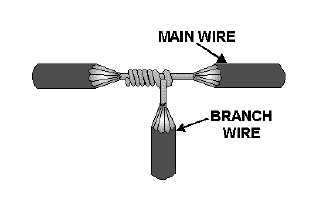2-8
Knotted Tap Joint
All the splices discussed up to this point are known as butted splices. Each was made by joining the
free ends of the conductors together. Sometimes, however, it is necessary to join a branch conductor to a
continuous wire called the main wire. Such a junction is called a tap joint.
The main wire, to which the branch wire is to be tapped, has about 1 inch of insulation removed. The
branch wire is stripped of about 3 inches of insulation. The knotted tap is shown in figure 2-9.
Figure 2-9.—Knotted tap joint.
The branch wire is laid behind the main wire. About three-fourths of the bare portion of the branch
wire extends above the main wire. The branch wire is brought under the main wire, around itself, and then
over the main wire to form a knot. The branch wire is then wrapped around the main conductor in short,
tight turns; and the end is trimmed off.
The knotted tap is used where the splice is subject to strain or slippage. When there is no strain, the
knot may be eliminated.
Wire Nut and Split Bolt Splices
The wire nut (view A of figure 2-10) is a device commonly used to replace the rattail joint splice.
The wire nut is housed in plastic insulating material. To use the wire nut, place the two stripped
conductors into the wire nut and twist the nut. In so doing, this will form a splice like the rattail joint and
insulate itself by drawing the wire insulation into the wire nut insulation.

